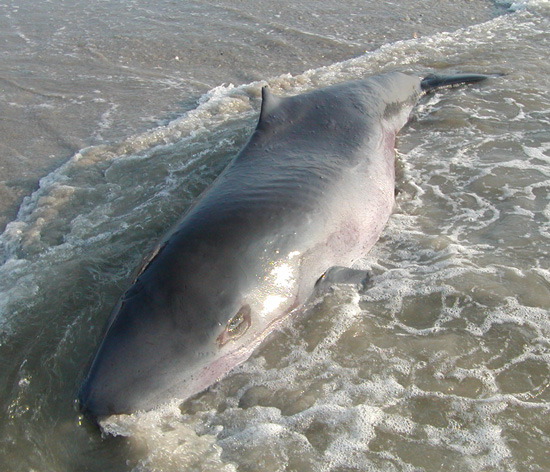|
| Distribution |
In NC, limited mainly to the Gulf Stream and waters farther offshore. It has been documented from all eight coastal counties in the state.
Warmer waters of the world, in the Atlantic mainly north to the northern states (off MA and ME). |
| Abundance |
Best considered as uncommon in NC waters (based on strandings), but poorly known across its range and in NC. Certainly not a rare species in NC, and might actually be fairly common, based on it being one of the more frequently stranded cetacean species in NC. Abundance as compared with the very similar Dwarf Pygmy Whale is not clear, but both are very seldom reported on offshore trips. However, this species has stranded much more frequently than the Dwarf; the Smithsonian National Museum of Natural History mammal collections (2021) lists a remarkable 63 stranding records for NC. |
| Seasonal Occurrence |
Strandings through 1995 (Webster et al., 1995) were rather frequent -- with 48 individuals found on beaches, in all months except for June. The NMNH database has stranding records for all 12 months, with slightly more in August and September. Thus, the species is a resident in NC waters and occurs throughout the year. |
| Habitat |
Warmer waters far offshore -- the Gulf Stream and beyond. Though there are numerous strandings, many or more represent females giving birth or with young. |
| Behavior |
As with the Dwarf Sperm Whale, it rests on the water surface with the back exposed, from the snout to the small dorsal fin, and thus can look like an overturned surfboard! |
| Comments |
This species is considered as Data Deficient by IUCN, as is the very similar Dwarf Pyrmy Whale. The Pygmy is larger than the Dwarf and has a smaller dorsal fin. |
| Origin |
Native |
| NC List |
Official |
 State Rank State Rank |
S3M |
| State Status |
|
 Global Rank Global Rank |
G4 |
| Federal Status |
|
| subspecies |
|
| other_comName |
|
| synonym |
|



